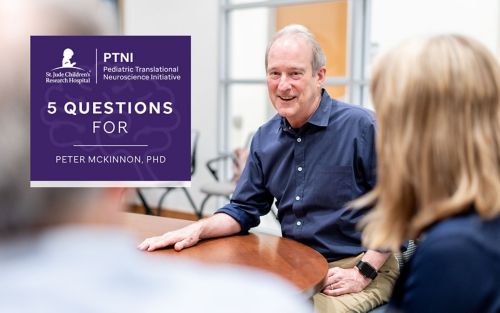St. Jude Family of Websites
Explore our cutting edge research, world-class patient care, career opportunities and more.
St. Jude Children's Research Hospital Home

- Fundraising
St. Jude Family of Websites
Explore our cutting edge research, world-class patient care, career opportunities and more.
St. Jude Children's Research Hospital Home

- Fundraising
5 Questions for Peter McKinnon, PhD

This question-and-answer series explores St. Jude investigators’ backgrounds, goals and accomplishments. Peter McKinnon, PhD, serves as Director of the Center for Pediatric Neurological Disease Research (CPNDR) within the Pediatric Translational Neuroscience Initiative (PTNI) and Vice-Chair of the St. Jude Department of Cell & Molecular Biology.
An established leader in neurological disease research, McKinnon has contributed significantly to understanding cellular responses to DNA damage and its link to disease, particularly neurological conditions such as ataxia-telangiectasia (A-T). By leveraging fundamental research approaches, McKinnon, as director of CPNDR, is laying the groundwork for understanding the pathogenesis (development) of rare pediatric neurological diseases like A-T and related disorders— and ultimately carrying this understanding from genetic discovery to therapy.
1. How has your research led you to the role of CPNDR Director?
My research has focused on understanding pediatric neurologic diseases such as A-T from a fundamental science perspective. Patients with this disease are also prone to cancer, and so there's been a longstanding interest in both the neurologic features and the cancer predisposition of this syndrome at St. Jude.
The defective ATM gene that leads to A-T is of extraordinary interest to scientists in many fields, not just cancer and neuroscience, but also immunology [individuals with A-T have immunodeficiency], general cell signaling, and cell biology. The protein is a major regulator of the DNA damage response, so A-T individuals are extremely X-ray sensitive. DNA stability in the nervous system in particular is vital because a spectrum of diseases manifest there that result from inherited mutations in a variety of DNA repair and DNA damage response factors.
So, I've had a longstanding interest in translational neuroscience. I have also known Paul [J. Paul Taylor, MD, PhD, Executive Vice President, Scientific Director, Chair of the Department of Cell and Molecular Biology and Director of PTNI] for many years. He was inspired by the revolution in the newer technologies that were effective in addressing certain neurologic diseases and engaged me in thinking about PTNI. As the whole concept evolved and gained support from leadership, I stepped into the role of director of the Center for Pediatric Neurologic Disease Research (CPNDR).
2. What role does fundamental research play in PTNI?
The goal is to generate a research enterprise that meshes with the rest of PTNI, where faculty and research are targeted at understanding the pathogenesis of a variety of pediatric neurologic diseases. Understanding disease pathogenesis provides insights for therapeutic strategies to address these debilitating diseases.
One of the differences when you compare PTNI to a program like the St. Jude Comprehensive Cancer Center is that with cancer, you want to kill the cells causing the disease. For neurological diseases, the therapy has to save the cells and stop cell death caused by the mutation that underpins the pathogenesis of the disease. These are two fundamentally different ways of looking at therapy.
Additionally, as treatments and therapies are initiated, whether they're based on antisense oligonucleotides (ASOs) to correct genetic defects in the underpinning gene mutations or small-molecule inhibitors of signaling pathways, it's critical to fully understand the natural history of the disease. When you're applying treatments, you must be able to know when you're effectively addressing the problems.
3. What makes St. Jude uniquely positioned to leverage fundamental research through CPNDR?
What St. Jude has done that is different from other institutions is integrating basic science with clinical science. In many other situations, you have independent laboratories working on diseases and coming up with therapeutic strategies, but there's often nowhere for them to go. It’s not always possible to engage a clinician or assemble the necessary resources to push what you’ve discovered into the clinic.
At the very beginning of everything we've done, there's been a concerted effort to integrate the basic and clinical aspects of PTNI. And that involves me, Paul, Richard [Richard Finkel, MD, Center for Experimental Neurotherapeutics (CENT) Director within PTNI], and Kristin [Kristin Stephenson, MHA, JD, Office of Strategy & Alliances (OSA) Director within PTNI]. Together, we've developed an incredible synergy where we're always talking to each other about what the next best steps are. We all meet very frequently and constantly strategize about approaches to therapies and directions to take PTNI.
4. How have you engaged outside of PTNI to drive the mission of CPNDR?
To push our work forward, we leverage state-of-the-art technology in conjunction with industry leaders. Kristin Stephenson and the Office of Strategy & Alliances in PTNI are bringing together pharma and biotech to help support our mission, and so we're incorporating the latest advances that industry is using for our therapeutic strategies in PTNI. Of course, Richard Finkel is one of the pioneers in antisense oligonucleotide treatment, having been instrumental in early ASO treatments for spinal muscular atrophy, so we have the expertise and the know-how within the Center for Experimental Neurotherapeutics to very quickly transition from the design of therapies to applying them in the clinic.
Another unique aspect critical to bringing therapies quickly and efficiently to the clinic is the availability of St Jude’s Good Manufacturing Practices [GMP] facility. When you start giving therapies to children, you must do so in a manner approved by the Food and Drug Administration [FDA] — you need a GMP facility.
Frank Fazio [President, Children’s GMP, LLC and Vice President, Therapeutics Production and Quality] has a wealth of experience, including in antisense oligonucleotides. So, we are developing the necessary expertise and capabilities to design and manufacture at therapy-grade levels. Having our own manufacturing component of PTNI really elevates what we can do, how quickly we can do it, and how efficiently we can do it. Fortunately, Frank has experience in the manufacturing essentials for ASO therapy development. PTNI is working closely with Frank to establish ASO production in the GMP.
Together, these elements set PTNI up for success, and position St. Jude as a leader in personalized medicine for neurologic (and other) diseases.
5. How do you envision CPNDR evolving in the future?
It’s important to have a broad portfolio of research that supports the PTNI mission. When we decide to focus research in a new direction, the phenomenal infrastructure at St. Jude allows us to be nimble and to get what’s needed done. We are actively recruiting faculty, which will be carefully selected to have research programs that mesh with the interests of PTNI. While we’re currently focused on ataxias, which are movement disorders, St. Jude faculty such as Heather Mefford, MD, PhD, [Department of Cell and Molecular Biology] specialize in disorders (such as epilepsy) for which we can apply the same experimental approaches used for treating ataxias.
Other faculty joining soon are experts in glial biology and neurodevelopmental diseases, all of which are relevant to the PTNI’s mission and the interests of the clinical and research groups here. This greatly enhances neuroscience at St. Jude.
CPNDR focuses on understanding disease indications relevant to the pediatric population. We are also developing other core resources that can be used by the neuroscience community in general at St. Jude, such as the tissue processing and histology core. Neurological disease is just where we're starting. Our preclinical design and development core will also be available to the institution as others become interested in different indications, including cancer. We expect that as CPNDR grows, it will continue to be an important resource institution-wide.







